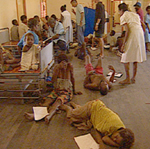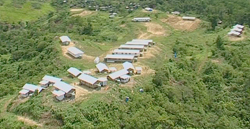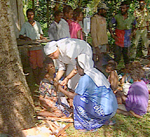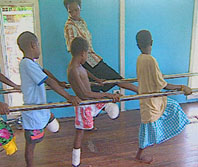TSUNAMI
The Great Tsunami
The coastal villages of Malol, Arop, Warapu and Sissano to the west of
Aitape provided a healthy environment for a community of 12,000
vigorous people engaged in fishing, commercial and gardening activities.
The thatched houses were right on the beach, which was a favourite
playground of the young children. Village life was good with established
schools and health centres.
All this changed at 7.10 pm on Friday, 17 July, 1998 when a 10-15 metre
tsunami, generated by a series of earthquakes out to sea measured at
magnitude 7, struck along 40 km of coast from the Bliri River to Aitape.
More than 2,100 died in a maelstrom of boiling waves, trees, parts of
houses and equipment tearing through the village with tremendous force,
sweeping all into the lagoon.
 Debris and bodies fetched up three kilometres away in the mangrove swamps on the far shore. Even substantial structures such as churches, clinics, and schools were swept away, leaving only concrete foundations behind.
Debris and bodies fetched up three kilometres away in the mangrove swamps on the far shore. Even substantial structures such as churches, clinics, and schools were swept away, leaving only concrete foundations behind.
 An emotional loss to the people was the grand Sissano church, built in 1925, the oldest building on the Aitape coast.
An emotional loss to the people was the grand Sissano church, built in 1925, the oldest building on the Aitape coast.
Left: Debris in Sissano Lagoon
Right: Remains of the grand Sissano Church at the Mission
The tsunami raced towards the shore at 35 km per hour in three waves.
Twenty minutes after the quake a towering tsunami loomed out of the
gloaming with the roar of a jet plane just as the people were preparing a
meal and planning entertainment for the evening. There was no warning
of the devastation that was seconds away. The first wave exposed the sea
floor and some children and adults went closer to see.
 The second wave
rode in on the back of the first and broke right in the middle of the
villages. A third lesser wave followed. Then the waters rushed back to
the ocean in multiple streams carrying bodies out to sea. The people fled
in terror, carrying the injured and burying some on the way to higher
ground and distant villages. The small streams leading away from the
lagoon were clogged with people walking or pushing canoes in the dark,
expecting another wave to overwhelm them at any moment.
The tragedy was that no one in Aitape realised the full extent of the damage and loss of life until early next morning when word came through from travellers and by radio.
The second wave
rode in on the back of the first and broke right in the middle of the
villages. A third lesser wave followed. Then the waters rushed back to
the ocean in multiple streams carrying bodies out to sea. The people fled
in terror, carrying the injured and burying some on the way to higher
ground and distant villages. The small streams leading away from the
lagoon were clogged with people walking or pushing canoes in the dark,
expecting another wave to overwhelm them at any moment.
The tragedy was that no one in Aitape realised the full extent of the damage and loss of life until early next morning when word came through from travellers and by radio.
Joseph Possani searches for his
daughter's body among the floating debris
The whole night people were in the water, in the mangroves, clambering up hills, crying out in pain
and calling for family members. Many prayed till dawn.
Emergency Action
Government and church emergency services immediately rushed to the
area to assess the damage and render aid in boats, and vehicles at Malol
and Arop. Appeals for help went out to Port Moresby and the nearby
towns of Wewak and Vanimo. A light aircraft over flew the devastated
area and later landed at Sissano airstrip with supplies and aid workers.
By the afternoon a helicopter arrived from a copper mine in the province and moved 95 of the most seriously injured patients to hospital.
 Doctors and nurses arrived from the bush stations. Food, water and clothing were
carried on back loads of the evacuation flights. By Sunday more
helicopters arrived with media crews from overseas and the whole world
saw the devastation along this beautiful coastline and wept with sorrow
over the destruction.
Doctors and nurses arrived from the bush stations. Food, water and clothing were
carried on back loads of the evacuation flights. By Sunday more
helicopters arrived with media crews from overseas and the whole world
saw the devastation along this beautiful coastline and wept with sorrow
over the destruction.
Army, police, Red Cross, World Vision, M.S.F. and ten other NGOs
rapidly sent teams into the area. Aircraft and helicopters kept bringing
materiel and aid workers till Aitape was bulging at the seams with harried
emergency staff. The Prime Minister and the Governor visited the area
and wept with the survivors.
Evacuation of the injured

Care Centres
The terrified victims fled to where they thought they would be safe. Some ended up at the far villages of Ramo, Pou and Romei. Others went to their own garden land or to old village sites up the creeks. They
gradually sorted themselves out into six organised care centres with appointed managers, nurses, police and counsellors doing what they
could to feed, clothe, shelter and console the people. Chopper pads were cut, store tents erected and temporary schools and aid posts built. These
sites later developed into regular villages with water tanks to supply clean water in most of them. New roads were pushed through for access by
truck.
Olbrum Care Centre
Statistics of Losses
The numbers of dead vary from 2,100 to 2,235 out of a total population of 12,000. 94 children were orphaned; 17 others lost a leg through injury or gangrene.
 Only 3 persons died in Aitape hospital, which is a tribute to the dedication and skill of the staff and volunteers.
Only 3 persons died in Aitape hospital, which is a tribute to the dedication and skill of the staff and volunteers.
 Hundreds were hospitalised in Aitape, Wewak and Vanimo, where.
The Australian Army erected a field hospital and performed scores of operations round the clock.
Hundreds were hospitalised in Aitape, Wewak and Vanimo, where.
The Australian Army erected a field hospital and performed scores of operations round the clock.
Left: Warapu Cemetery
Right: Day 1 in Raihu Hospital
The 130-bed mission hospital at Aitape was overflowing with patients, so
the less serious were moved to nearby schools and to Wewak and
Vanimo. The operating theatre was like a scene from M.A.S.H, going
from 0800 to 2200 with two doctors. More surgeons and nurses arrived
soon to relieve the exhausted mission staff.
Appeals for Assistance
Supplies arrived from all over the world by air, sea and road from
Wewak. The response from inside and outside the country was
extraordinary. Provincial governments in PNG sent planeloads of
emergency supplies and generous donations. In Australia children and
adults got together parcels of what was required and sent it with their love expressed on colourful cards to the shattered people in the care centres. The diocesan team was right in the midst of all the activity, particularly in the medical and counselling fields. The volume of goods was so large that a central warehouse had to be established by the diocese to direct the distribution of aid of all types.

Establishment of the Diocesan Rehabilitation Committee
Within days of the disaster, Fr. Austen Crapp ofm (later Bishop) recognized the enormity of the situation and took a definitive step to ensure the Diocese's continuing involvement in the disaster program would not get in the way of normal Diocesan work and responsibilities, by setting up the Diocesan Rehabilitation Committee.
Fitted out as an autonomous office, the Rehabilitation Committee administered the donations received, liased with Governmental Departments and NGO's in the provision of schools, health services and counselling for the affected people. Organization of bursaries and trust accounts ensured that victims received all the assistance and counseling possible to minimize the effects of the trauma.
Fr. Austen at Warapu
Specifically the aims of the Diocese of Aitape Rehabilitation Program were:
- To administer, disperse and account for all donations received from all sources for the welfare of the victims.
- To fully cooperate with all departments of the government and NGO's who may be active in road works, relocation and construction of village facilities for the physical well being of the victims.
- To improve existing diocesan facilities for the benefit of the victims.
- To pay particular attention to the pastoral and psychological needs of the victims by providing the pastoral and counseling teams with any transport equipment and accommodation which they require.
- To arrange for bursaries and trust accounts to assist orphans, students or other particular needy persons among the victims.
This committee, directed by Mr. Balthaser Maketu of Sissano, who lost
his mother in the tsunami, became the main provider of schools, health
sub-centres, roads, counselling and pastoral programmes for the care
centers.
 The dedicated staff worked tirelessly for two years with Rotary
Australia building teams, doctors, nurses, shipping, helicopter and
transport organizations, provincial and national government departments
and a host of other NGO disaster teams to rebuild the shattered hopes of
the coastal people. Their magnificent efforts will never be forgotten by
the people of Aitape.
The dedicated staff worked tirelessly for two years with Rotary
Australia building teams, doctors, nurses, shipping, helicopter and
transport organizations, provincial and national government departments
and a host of other NGO disaster teams to rebuild the shattered hopes of
the coastal people. Their magnificent efforts will never be forgotten by
the people of Aitape.
Left: Olbrum Reconstruction
Counselling Teams
A particular concern of the Rehab committee was making counselling
services widely available to the leaders, teachers, children, nurses,
mothers and any other groups of persons from the affected villages who
were suffering trauma. Medical attention was the priority in the first days of the disaster but the Rehab committee realized that the wounds to the minds and souls of the victims are equally as damaging.
 To alleviate this psychological pain we set up a programme called Wok Sambai- a
psychosocial counselling service - directed by trained counsellors and
using local trainees to bring help to the terribly traumatized people. For weeks the people were almost catatonic with shock and badly needed to
have someone attend to their deep concerns. Several were suicidal.
To alleviate this psychological pain we set up a programme called Wok Sambai- a
psychosocial counselling service - directed by trained counsellors and
using local trainees to bring help to the terribly traumatized people. For weeks the people were almost catatonic with shock and badly needed to
have someone attend to their deep concerns. Several were suicidal.
Right: These two sisters were part of the team of trained counsellors who helped assist with the injured
The first trainers came out of Bougainville, where they had been
counselling the traumatized victims of the ten-year war. They pointed out
that a mistake was made in the Bougainville situation in not bringing
counselling services to the victims until nearly seven years had passed.
For many it was too late to heal the psychological wounds. In the second
week of the Aitape disaster teams of sisters and priests lived in the care
centres to give spiritual consolation to the people.
 But they realized
quickly that more was required. So the Wok Sambai began. It trained
over 300 village counsellors.
But they realized
quickly that more was required. So the Wok Sambai began. It trained
over 300 village counsellors.
Fr Antonine Centre
The 11 amputees, mainly children, needed special care and equipment.
The centre for disabled was expanded and equipped to handle the
manufacture of prosthetics with professional assistance and training from
the national centre in Lae. This service continues today to attend to the ongoing medical and social care of the amputees and disabled.
Right: Group of young amputees undergoing physiotherapy exercises
The Present Situation
Although the Rehabilitation Committee has done its job and is now
disbanded, the upgrading of the education facilities and roads in the new
villages is not yet complete. Extra classrooms and teachers’ houses were
required in line with a national education reform programme, which was
not in place at the time of the tsunami. The diocese took up the task once again of finding funds and constructing the buildings. Eight out of nine schools are upgraded and the other will be started in the New Year.
Because the donors who came to the rescue of the people so generously
after the tsunami were interested in physical and social rehabilitation and not the religious aspect of the operation, the diocese used no donated
funds for building churches in the new villages. We realized that the faith of the people, who are mostly catholic, was a key factor in their
rehabilitation and priests, pastoral workers and religious flocked to their succour with Mass, the Sacraments and counselling. The people
immediately constructed a small church with whatever materials were to
hand in the bush as soon as they settled in a new location. These bush
churches have served them until now as the centre of their faith
commitment. Now that other building programmes are all but complete
we have turned our attention to finding funds and builders to give each
village a new church.See Haus Lotu Project
Donors
We would like to thank all the donors that have given their support to the
Diocesan Rehabilitation Committee to bring much needed help to the
people of the tsunami disaster. Without their generous assistance
rehabilitation of the area would have been impossible. In the weeks after
the tsunami, the diocese received many letters and cheques from
individuals and organizations both within and outside Papua New Guinea.
Our major donors were Caritas (PNG, Australia and New Zealand),
Memisa (who have a long involvement with the Raihu health centre) and
The Franciscans (through the Franciscan Missionary Union in Australia
and Missionzentrale in Germany), other churches (particularly Anglican)
and Rotary Australia. In reality our private and corporate donors are too
many to mention by name. Families of the religious and other people
working in Aitape raised funds and public awareness. One lady was
responsible for raising over K60,000 and on a single night at a function in Brisbane. Friends of an Aitape businessman raised A$ 40,000 in a week.
Many schools in Australia also responded with donations of money, books, stationary and letters of sympathy to the children. Even now unused funds trickle in from various sources to continue supplying school materials and fees for the children. Rotary teams are still building medical facilities for the people.
To all the wonderful persons who gave their resources or time to the
diocesan rehabilitation campaign we offer our heartfelt thanks and
prayers for your continual welfare. Without you our efforts would have
been paltry indeed.
 Debris and bodies fetched up three kilometres away in the mangrove swamps on the far shore. Even substantial structures such as churches, clinics, and schools were swept away, leaving only concrete foundations behind.
Debris and bodies fetched up three kilometres away in the mangrove swamps on the far shore. Even substantial structures such as churches, clinics, and schools were swept away, leaving only concrete foundations behind.
 An emotional loss to the people was the grand Sissano church, built in 1925, the oldest building on the Aitape coast.
An emotional loss to the people was the grand Sissano church, built in 1925, the oldest building on the Aitape coast.
 The second wave
rode in on the back of the first and broke right in the middle of the
villages. A third lesser wave followed. Then the waters rushed back to
the ocean in multiple streams carrying bodies out to sea. The people fled
in terror, carrying the injured and burying some on the way to higher
ground and distant villages. The small streams leading away from the
lagoon were clogged with people walking or pushing canoes in the dark,
expecting another wave to overwhelm them at any moment.
The tragedy was that no one in Aitape realised the full extent of the damage and loss of life until early next morning when word came through from travellers and by radio.
The second wave
rode in on the back of the first and broke right in the middle of the
villages. A third lesser wave followed. Then the waters rushed back to
the ocean in multiple streams carrying bodies out to sea. The people fled
in terror, carrying the injured and burying some on the way to higher
ground and distant villages. The small streams leading away from the
lagoon were clogged with people walking or pushing canoes in the dark,
expecting another wave to overwhelm them at any moment.
The tragedy was that no one in Aitape realised the full extent of the damage and loss of life until early next morning when word came through from travellers and by radio.
 Doctors and nurses arrived from the bush stations. Food, water and clothing were
carried on back loads of the evacuation flights. By Sunday more
helicopters arrived with media crews from overseas and the whole world
saw the devastation along this beautiful coastline and wept with sorrow
over the destruction.
Doctors and nurses arrived from the bush stations. Food, water and clothing were
carried on back loads of the evacuation flights. By Sunday more
helicopters arrived with media crews from overseas and the whole world
saw the devastation along this beautiful coastline and wept with sorrow
over the destruction.

 Only 3 persons died in Aitape hospital, which is a tribute to the dedication and skill of the staff and volunteers.
Only 3 persons died in Aitape hospital, which is a tribute to the dedication and skill of the staff and volunteers.
 Hundreds were hospitalised in Aitape, Wewak and Vanimo, where.
The Australian Army erected a field hospital and performed scores of operations round the clock.
Hundreds were hospitalised in Aitape, Wewak and Vanimo, where.
The Australian Army erected a field hospital and performed scores of operations round the clock.

 The dedicated staff worked tirelessly for two years with Rotary
Australia building teams, doctors, nurses, shipping, helicopter and
transport organizations, provincial and national government departments
and a host of other NGO disaster teams to rebuild the shattered hopes of
the coastal people. Their magnificent efforts will never be forgotten by
the people of Aitape.
The dedicated staff worked tirelessly for two years with Rotary
Australia building teams, doctors, nurses, shipping, helicopter and
transport organizations, provincial and national government departments
and a host of other NGO disaster teams to rebuild the shattered hopes of
the coastal people. Their magnificent efforts will never be forgotten by
the people of Aitape.
 To alleviate this psychological pain we set up a programme called Wok Sambai- a
psychosocial counselling service - directed by trained counsellors and
using local trainees to bring help to the terribly traumatized people. For weeks the people were almost catatonic with shock and badly needed to
have someone attend to their deep concerns. Several were suicidal.
To alleviate this psychological pain we set up a programme called Wok Sambai- a
psychosocial counselling service - directed by trained counsellors and
using local trainees to bring help to the terribly traumatized people. For weeks the people were almost catatonic with shock and badly needed to
have someone attend to their deep concerns. Several were suicidal.
 But they realized
quickly that more was required. So the Wok Sambai began. It trained
over 300 village counsellors.
But they realized
quickly that more was required. So the Wok Sambai began. It trained
over 300 village counsellors.